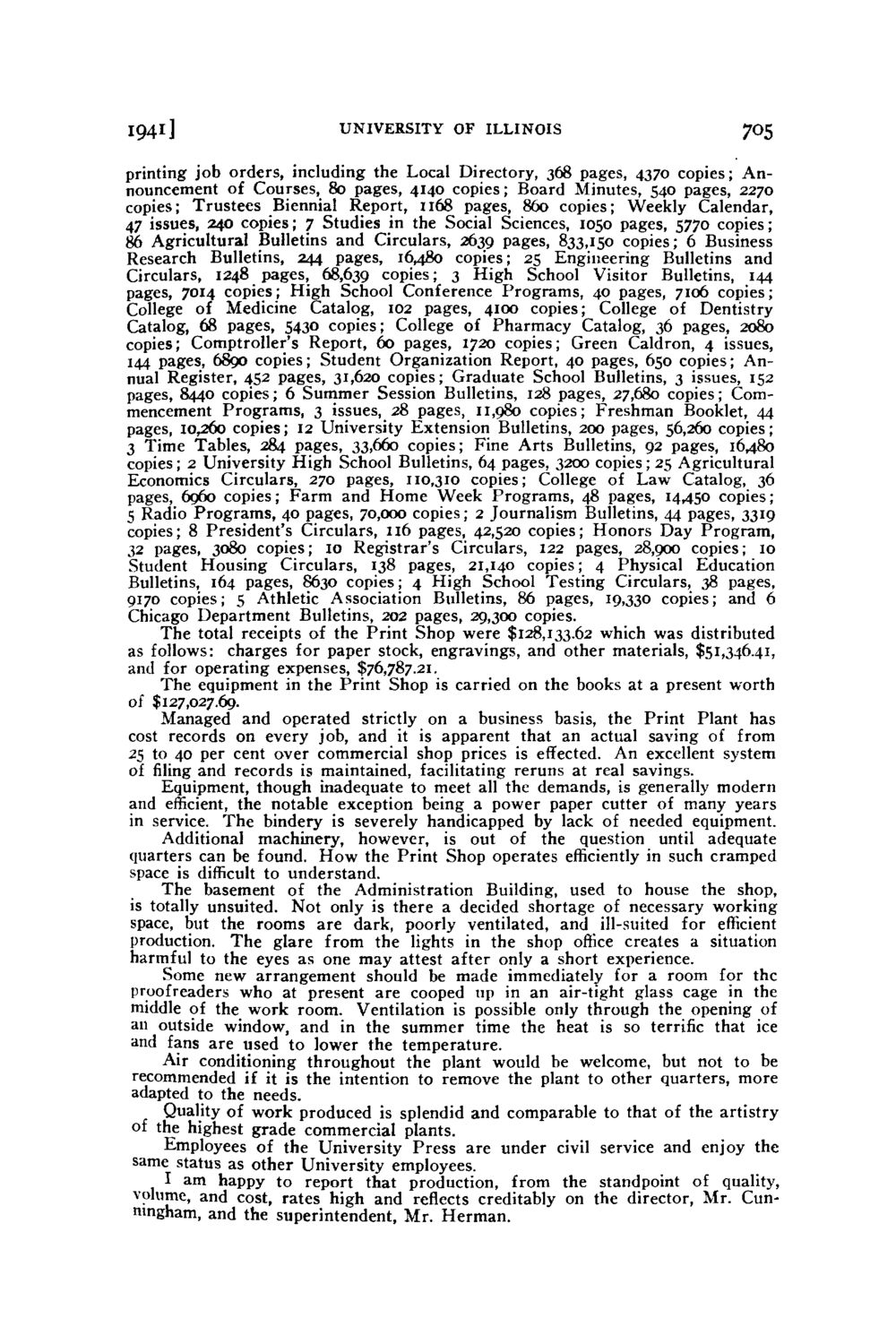| |
| |
Caption: Board of Trustees Minutes - 1942
This is a reduced-resolution page image for fast online browsing.

EXTRACTED TEXT FROM PAGE:
I94i] UNIVERSITY OF ILLINOIS 705 printing job orders, including the Local Directory, 368 pages, 4370 copies; Announcement of Courses, 80 pages, 4140 copies; Board Minutes, 540 pages, 2270 copies; Trustees Biennial Report, 1168 pages, 860 copies; Weekly Calendar, 47 issues, 240 copies; 7 Studies in the Social Sciences, 1050 pages, 5770 copies; 86 Agricultural Bulletins and Circulars, 2639 pages, 833,150 copies; 6 Business Research Bulletins, 244 pages, 16480 copies; 25 Engineering Bulletins and Circulars, 1248 pages, 68,639 copies; 3 High School Visitor Bulletins, 144 pages, 7014 copies; H i g h School Conference Programs, 40 pages, 7106 copies; College of Medicine Catalog, 102 pages, 4100 copies; College of Dentistry Catalog, 68 pages, 5430 copies; College of Pharmacy Catalog, 36 pages, 2080 copies; Comptroller's Report, 60 pages, 1720 copies; Green Caldron, 4 issues, 144 pages, 6890 copies; Student Organization Report, 40 pages, 650 copies; Annual Register, 452 pages, 31,620 copies; Graduate School Bulletins, 3 issues, 152 pages, 8440 copies; 6 Summer Session Bulletins, 128 pages, 27,680 copies; Commencement Programs, 3 issues, 28 pages, 11,980 copies; Freshman Booklet, 44 pages, 10,260 copies; 12 University Extension Bulletins, 200 pages, 56,260 copies; 3 Time Tables, 284 pages, 33,660 copies; Fine Arts Bulletins, 92 pages, 16480 copies; 2 University High School Bulletins, 64 pages, 3200 copies; 25 Agricultural Economics Circulars, 270 pages, 110,310 copies; College of Law Catalog, 36 pages, 6960 copies; F a r m and H o m e Week Programs, 48 pages, 14450 copies; 5 Radio P r o g r a m s , 40 pages, 70,000 copies; 2 Journalism Bulletins, 44 pages, 3319 copies; 8 President's Circulars, 116 pages, 42,520 copies; Honors Day Program, 32 pages, 3080 copies; 10 Registrar's Circulars, 122 pages, 28,900 copies; 10 Student Housing Circulars, 138 pages, 21,140 copies; 4 Physical Education Bulletins, 164 pages, 8630 copies; 4 High School Testing Circulars, 38 pages, 9170 copies; 5 Athletic Association Bulletins, 86 pages, 19,330 copies; and 6 Chicago Department Bulletins, 202 pages, 29,300 copies. The total receipts of the Print Shop were $128,133.62 which was distributed as follows: charges for paper stock, engravings, and other materials, $51,346.41, and for operating expenses, $76,787.21. The equipment in the Print Shop is carried on the books at a present worth of $127,027.69. Managed and operated strictly on a business basis, the Print Plant has cost records on every job, and it is apparent that an actual saving of from 25 to 40 per cent over commercial shop prices is effected. An excellent system of filing and records is maintained, facilitating reruns at real savings. Equipment, though inadequate to meet all the demands, is generally modern and efficient, the notable exception being a power paper cutter of many years in service. T h e bindery is severely handicapped by lack of needed equipment. Additional machinery, however, is out of the question until adequate quarters can be found. H o w the Print Shop operates efficiently in such cramped space is difficult to understand. The basement of the Administration Building, used to house the shop, is totally unsuited. Not only is there a decided shortage of necessary working space, but the rooms are dark, poorly ventilated, and ill-suited for efficient production. T h e glare from the lights in the shop office creates a situation harmful to the eyes as one may attest after only a short experience. Some new arrangement should be made immediately for a room for the proofreaders who at present are cooped up in an air-tight glass cage in the middle of the work room. Ventilation is possible only through the opening of an outside window, and in the summer time the heat is so terrific that ice and fans are used to lower the temperature. Air conditioning throughout the plant would be welcome, but not to be recommended if it is the intention to remove the plant to other quarters, more adapted to the needs. Quality of work produced is splendid and comparable to that of the artistry of the highest grade commercial plants. Employees of the University Press are under civil service and enjoy the same status as other University employees. I am happy to report that production, from the standpoint of quality, volume, and cost, rates high and reflects creditably on the director, Mr. Cunningham, and the superintendent, Mr. H e r m a n .
| |